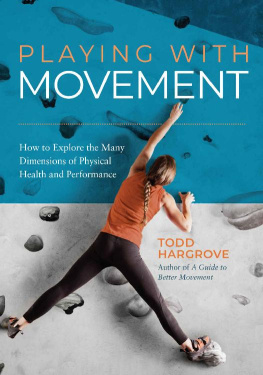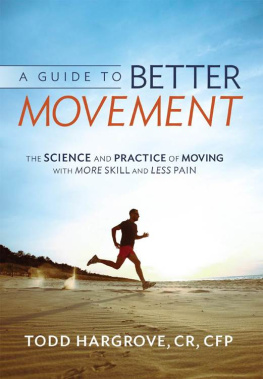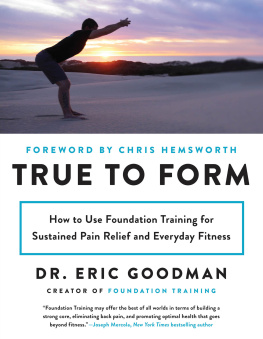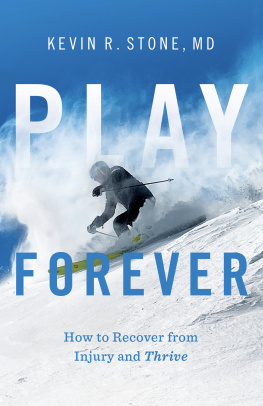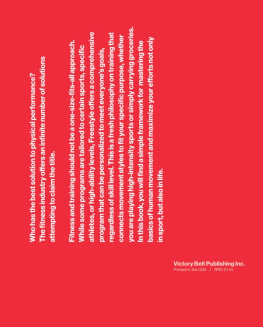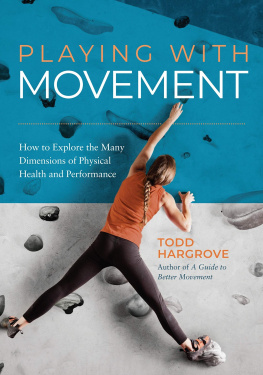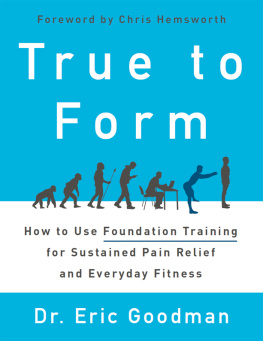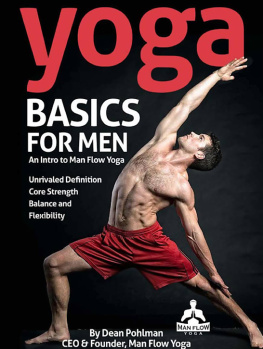Copyright 2019 Todd R. Hargrove
No part of this publication may be reproduced, stored in a retrievable system or transmitted, in any form or by any means electronic, mechanical, photocopying, recording, or otherwise without prior written permission, except for the inclusion of brief quotations in review.
For information about this title or to order other books and or electronic media, contact the publisher:
Cover design by Dan Shafer.
Interior design by The Book Designers.
Thanks to Carolyn Silvernail for diagrams, drawings and assistance with cover design.
All forms of exercise carry some risk. Readers are advised to take full responsibility for their safety and their limits. The advice in this book is in no way intended to be a substitute for any advice provided by your doctor or other medical professional. The information in this book is true and correct to the best of the authors knowledge. However, science is always advancing, and therefore the information may become outdated or proven incorrect. The author and publisher disclaim all liability for damages caused by applying the recommendations in this book.
ACKNOWLEDGMENTS
T hanks to clients, colleagues and teachers for giving me the information, inspiration or support to write this book. In particular:
Jason Silvernail, Christopher Johnson, Ben Cormack, Neil OConnell, Nick Tuminello, Carolyn Silvernail, Tasha Stanton, Derek Griffin, Joletta Belton, Jules Mitchell, Ole Marten Salte, Lars Avenmarie, Rajam Roose, Rafe Kelly, Weston Edwards, Sigurd Mikkelsen, James Steele, Adam Bjerre, Israel Halperin, Keith Waldron, Cory Blickenstaff, Bronnie Lenox Thompson, Travis Pollen, Tim Rowland, Jarod Hall, Jarlo Ilano, Carrie Hall, Ryan Appell, Craig Liebenson, Eric Kruger, Allison Sim, Joletta Belton, Peter OSullivan, Kjartan Vibe Fersum, Sarah Haag, Sandy Hilton, Kieran OSullivan, Lorimer Moseley, David Butler, Mladen Jovanovic, Rob Gray, Paul Glazier, John Kiely, Frans Bosch, Scott Morrison, Jeremy Frisch, Jill Cook, Chris Beardsley, Nick Winkleman, Alex Hutchinson, Steve Magness, Craig Payne, Steven Pinker, Dan Dennett, Steve Novella, David Chapman, Robert Sapolsky. And many others I have forgotten!
Special thanks to Paul Ingraham, Stephan Guyenet and Greg Lehman for invaluable assistance with the draft.
And thanks to my family and friends for their love and support, especially Jemila, Juniper and Abezash.
CONTENTS

INTRODUCTION
I ts a great gift to move your body in a way that feels strong, creative or skillful. We tend to celebrate cognitive feats like art and science as being the pride of the human species, but as movers we are not so shabby either. Humans are not the fastest or strongest animals, but we are unmatched in our versatility. We can do back flips, run for miles at a stretch, dance ballet, lift hundreds of pounds, do cartwheels, shoot long-range three pointers, climb trees and cliffs, throw curveballs, swim through oceans and lakes, and play the harmonica. Of course, not every human can do all these things (or even one!), but we all have the potential to develop an amazing variety of physical abilities. We are born to run, and also to walk, climb, dance and do millions of other things.
Unfortunately, modern humans are struggling with their movement health. Only a quarter of Americans meet the recommended physical activity guidelines, and this increases the risk for a long list of diseases.
Adults have workout routines, but the experience is often exactly that - work and routine. The average exercise program is not very fun or meaningful. This is part of the reason exercise feels like a chore, and why most people dont do it with enough volume, variety, and intensity to get its beneficial effects. Everyone knows that physical activity provides the health benefits of a miracle drug, but few get a sufficient dose. Maybe this shouldnt be surprising - branding movement as medicine makes it sound like something you would rather avoid.
If you are reading this book, you have probably already tried various methods to help yourself or others move better and feel better. Perhaps you have focused on training specific attributes like posture, mobility, or strength. Or maybe you have tried various treatment options for pain - physical therapy, corrective exercise, yoga, chiropractic, or even surgery. This book will help you understand why these methods have succeeded or failed, and how to make better choices in the future. Most importantly, it will help you take more control of your movement health, in a way that is personally meaningful to you, with less reliance on experts.
In other words, this book is about helping you solve movement problems, such as completing your first marathon, recovering from back pain, putting on more muscle, or improving your agility on the soccer field. These challenges are all complex, meaning they depend on millions of interlocking variables muscular, skeletal, physiological, psychological, neurological, and environmental. With so many unknowns, the pathway to success will be somewhat different for each individual, and finding it will require some exploration.
Play is a natural behavior that evolved to help animals solve complex problems in the face of uncertainty. If you want to get better at a sport, find a sustainable exercise program, or even get out of pain, you will need to play with movement. This means moving in a way that is fun, exploratory, variable, intuitive, and personally meaningful. All animals develop skill, resilience, and well-rounded fitness through play, not working out. But the mainstream approach to training and therapy is all work no play. It is focused on movements that are boring, repetitive, planned, stressful, and done only to accomplish some external goal. This stems from a reductive mindset that views the body as a machine to be fixed, as opposed to an organic self-organizing system that adapts and learns. This causes a wide range of common problems, including:
Pain treatments that are highly medicalized, expensive, and ineffective.
Policing of normal patterns of posture and movement as dysfunctions that need to be corrected.
Sport training that relies heavily on repetitive and specialized drills, as opposed to varied games.
Exercise programs that are meaningless and dispiriting.
The arguments in this book are not based on romantic feel-good reasoning, or nostalgia for sunny days at the park when we were children. They rely on a substantial body of evidence and theory pulled from diverse fields of study, including the sciences of play, complex systems, pain, motor control, exercise physiology, and psychology. They show that mainstream formulas for movement health are often seriously off base. The pathway to physical wellness is not about following a recipe, but going on a meaningful adventure.
Issac Asimov noted that scientific truths are usually accessed through unexpected pathways:
The most exciting phrase to hear in science, the one that heralds new discoveries, is not Eureka! (I found it!) but Thats funny ...
Babies are curious scientists of movement. They are constantly experimenting with different ways to perform important tasks, like how to crawl, drop food off a table, or get a foot into their mouth. They dont know how to do these things, so they need to randomly explore different options until they get an interesting result. When a baby rolls over for the first time, it is often the accidental effect of trying to reach for a toy that is out of grasp. In terms of Asimovs quote, they are probably thinking hmm thats funny.

